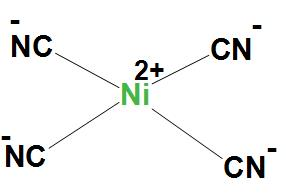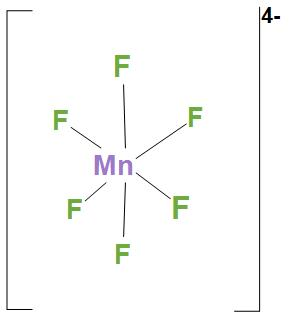Answer
397.2k+ views
Hint As we know that hybridization is the process of producing a degenerated type of orbital by mixing two atomic orbitals with the same energy levels. During hybridization, atomic orbitals are mixed and a new hybrid orbital is formed.
Complete Step by step solution:
- In $Ni{{\left( CO \right)}_{4}}$, Ni atom is $s{{p}^{3}}$ hybridised. And this will lead to a tetrahedral geometry. We can see the structure:

- In $Ni\left( CN \right)_{4}^{2-}$, Ni atom is $ds{{p}^{2}}$ hybridised. And this will lead to a square planar geometry.
Here, $Ni\left( CN \right)_{4}^{2-}$ is showing $ds{{p}^{2}}$ hybridisation, because here CN group is a strong field ligand and it forms inner complexes. We can see the structure:

- In $Fe\left( CN \right)_{6}^{4-}$, Ni atom is ${{d}^{2}}s{{p}^{3}}$ hybridised. And this will lead to an octahedral geometry. Here, $Fe\left( CN \right)_{6}^{4-}$ is showing ${{d}^{2}}s{{p}^{3}}$ hybridisation, because here cyanide group is present. And as we know that cyanide group is a strong field ligand and it forms inner complexes. We can see the structure:

- In $MnF_{6}^{4-}$, Ni atom is $s{{p}^{3}}{{d}^{2}}$ hybridised. And this will lead to an octahedral geometry. We can see the structure:

Hence, we can say that correct option is (d), that is A-1, B-2, C-4, D-3
Note:
- We must note the key features of hybridization: the atomic orbitals that have equal energies undergo hybridization. Shape of any molecule can be predicted from hybridization.
- The number of hybrid orbitals that are formed during hybridization will be equal to the number of atomic orbitals mixed.
Complete Step by step solution:
- In $Ni{{\left( CO \right)}_{4}}$, Ni atom is $s{{p}^{3}}$ hybridised. And this will lead to a tetrahedral geometry. We can see the structure:

- In $Ni\left( CN \right)_{4}^{2-}$, Ni atom is $ds{{p}^{2}}$ hybridised. And this will lead to a square planar geometry.
Here, $Ni\left( CN \right)_{4}^{2-}$ is showing $ds{{p}^{2}}$ hybridisation, because here CN group is a strong field ligand and it forms inner complexes. We can see the structure:

- In $Fe\left( CN \right)_{6}^{4-}$, Ni atom is ${{d}^{2}}s{{p}^{3}}$ hybridised. And this will lead to an octahedral geometry. Here, $Fe\left( CN \right)_{6}^{4-}$ is showing ${{d}^{2}}s{{p}^{3}}$ hybridisation, because here cyanide group is present. And as we know that cyanide group is a strong field ligand and it forms inner complexes. We can see the structure:

- In $MnF_{6}^{4-}$, Ni atom is $s{{p}^{3}}{{d}^{2}}$ hybridised. And this will lead to an octahedral geometry. We can see the structure:

Hence, we can say that correct option is (d), that is A-1, B-2, C-4, D-3
Note:
- We must note the key features of hybridization: the atomic orbitals that have equal energies undergo hybridization. Shape of any molecule can be predicted from hybridization.
- The number of hybrid orbitals that are formed during hybridization will be equal to the number of atomic orbitals mixed.
Recently Updated Pages
How many sigma and pi bonds are present in HCequiv class 11 chemistry CBSE

Why Are Noble Gases NonReactive class 11 chemistry CBSE

Let X and Y be the sets of all positive divisors of class 11 maths CBSE

Let x and y be 2 real numbers which satisfy the equations class 11 maths CBSE

Let x 4log 2sqrt 9k 1 + 7 and y dfrac132log 2sqrt5 class 11 maths CBSE

Let x22ax+b20 and x22bx+a20 be two equations Then the class 11 maths CBSE

Trending doubts
Fill the blanks with the suitable prepositions 1 The class 9 english CBSE

At which age domestication of animals started A Neolithic class 11 social science CBSE

Which are the Top 10 Largest Countries of the World?

Give 10 examples for herbs , shrubs , climbers , creepers

Difference between Prokaryotic cell and Eukaryotic class 11 biology CBSE

Difference Between Plant Cell and Animal Cell

Write a letter to the principal requesting him to grant class 10 english CBSE

Change the following sentences into negative and interrogative class 10 english CBSE

Fill in the blanks A 1 lakh ten thousand B 1 million class 9 maths CBSE



